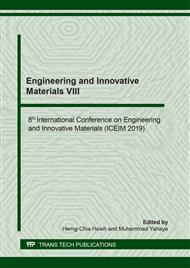[1]
Fukano T. and Kariyasaki A., Characteristics of Gas-Liquid Two-Phase Flow in a Capillary Tube,, Nucl. Eng. Des., vol. 141, p.59–68, (1993).
DOI: 10.1016/0029-5493(93)90092-n
Google Scholar
[2]
A. M.I., M. Sadatomi, and M. Kawaji, Adiabatic Two-Phase Flow in Narrow Channels Between Two Flat Plates,, Can. J. Chem. Eng, vol. 71, no. 5, p.657–666, (1993).
DOI: 10.1002/cjce.5450710502
Google Scholar
[3]
K. A. Triplett, S. M. Ghiaasiaan, S. I. Abdel-Khalik, and D. I. Sadowski, GasLiquid Two-Phase Flow in Microchannels Part II: void fraction and pressure drop,, Int. J. Multiph. Flow, vol. 28, p.395–410, (1999).
DOI: 10.1016/s0301-9322(98)00054-8
Google Scholar
[4]
K. A, C. P.M., and K. M, Investigation of Two-Phase Flow Pattern, Void Fraction and Pressure Drop in a Microchannel,, Int. J. Multiph. Flow, vol. 28, p.1411–1435, (2002).
DOI: 10.1016/s0301-9322(02)00037-x
Google Scholar
[5]
Agnieszka Ładosz, Eugen Rigger And Philipp Rudolf Von Rohr, Pressure Drop of Three-Phase Liquid-Liquid-Gas Slug Flow in Round Microchannels,, Proceeding of Microfluidics and Nanofluidics, https://link.springer.com/article/10.1007/s10404-016-1712-7. (29 February 2016).
DOI: 10.1007/s10404-016-1712-7
Google Scholar
[6]
P. M. Y. Chung and M. Kawaji, The effect of Channel Diameter on Adiabatic Two-Phase Flow Characteristics in Microchannel,, Int. J Multiohase Flow, vol. 30, p.735–761, (2004).
DOI: 10.1016/j.ijmultiphaseflow.2004.05.002
Google Scholar
[7]
Chung, P.M.Y., Kawaji, M., The Effect of Channel Diameter on Adiabatic Two-Phase Flow Characteristic in Microchannels, International Journal of Multiphase Flow, Vol. 30, pp.735-761, (2004).
DOI: 10.1016/j.ijmultiphaseflow.2004.05.002
Google Scholar
[8]
M. Sadatomi, A. Kawahara, M. Matsuo, and K. Ishimura, Effects of Surface Tension on Two-Phase Gas-Liquid Flows in Horizontal Small Diameter Pipes,, Jounal Power Energy Syst., vol. 4, no. 2, p.290–300, (2010).
DOI: 10.1299/jpes.4.290
Google Scholar
[9]
Sudarja, Deendarlianto, Indarto, and H. Aqli, Experimental Study on the Void Fraction of Air-Water Two-Phase Flow in a Horizontal Circular Mini-Channel,, in AIP Conference Proceeding. (2015).
DOI: 10.1063/1.4949302
Google Scholar
[10]
S. Saisorn and S. Wongwises, Flow Pattern, Void Fraction and Pressure Drop of Two-Phase Air-Water Flow in a Horizontal Circular Micro-Channel,, Exp. Therm. Fluid Sci., vol. 32, no. 3, p.748–760. (2008).
DOI: 10.1016/j.expthermflusci.2007.09.005
Google Scholar
[11]
M.I. Ali, M. Sadatomi, M. K. Adiabatic Two-Phase flow in narrow channels between two flat plates, 71, 657–666. (1993).
DOI: 10.1002/cjce.5450710502
Google Scholar
[12]
Serizawa, A., Feng, Z., & Kawara, Z. Two-phase flow in microchannels. Experimental Thermal and Fluid Science. (2002).
DOI: 10.1016/s0894-1777(02)00175-9
Google Scholar
[13]
Mayor, T.S., Pinto, A.M.F.R., Campos, J.B.L.M., 2007, An Image Analysis Technique for The Study of Gas-Liquid Slug Flow along Vertical Pipes – Associated Uncertainty, Flow Measurement and Instrumentation, Vol 18, pp.139-147.
DOI: 10.1016/j.flowmeasinst.2007.05.004
Google Scholar
[14]
Deendarlianto, M. Andrianto, A. Widyaparaga, O. Dinaryanto, Khasani, and Indarto, CFD Studies on the Gas-Liquid plug two-phase flow in a horizontal pipe,, Journal of Petroleum Science and Engineering, (2016).
DOI: 10.1016/j.petrol.2016.09.019
Google Scholar
[15]
E. A. Chinnov, F. V. Ron'shin, and O. A. Kabov, Two-Phase Flow Patterns In Short Horizontal Rectangular Microchannels,, International Journal Of Multiphase Flow, (2015).
DOI: 10.1016/j.ijmultiphaseflow.2015.11.006
Google Scholar
[16]
H. A. Khaledi, I. E Smith, T. E. Unander, and J. Nossen, Investigation Of Two-Phase Flow Pattern, Liquid Holdup and Pressure Drop In Viscous Oil-Gas Flow,, International Journal Of Multiphase Flow, 37-51, (2014).
DOI: 10.1016/j.ijmultiphaseflow.2014.07.006
Google Scholar
[17]
R. Sihombing: Pressure Drop of Liquid and Gas Flow at Sudden enlargement cross-section of Rectangle Vertical Channels., Electronic ROTOR Journal, Vol. 1. (2013).
Google Scholar
[18]
Tat Thang Nguyen, Hiroshige Kikura, Hideki Murakawa, Nobuyoshi Tsuzuki, Measurement of bubbly two-phase flow in vertical pipe using multiwave ultrasonic pulsed Dopller method and wire mesh tomography, Energy Procedia, Vol. 71 (2015 ), pp.337-351.
DOI: 10.1016/j.egypro.2014.11.887
Google Scholar


